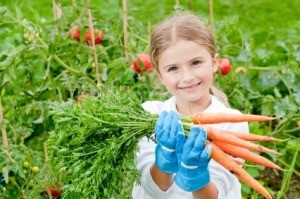 Anyone that takes the time and effort to teach a child to garden will reap great rewards for their effort. In fact, we all will. Children who develop an appreciation for nature are more likely to become good stewards of the environment as they grow. Being responsible for tending a garden also fosters a sense of "nurturing" and helps them learn to care for other living things.
Anyone that takes the time and effort to teach a child to garden will reap great rewards for their effort. In fact, we all will. Children who develop an appreciation for nature are more likely to become good stewards of the environment as they grow. Being responsible for tending a garden also fosters a sense of "nurturing" and helps them learn to care for other living things.
Lessons Gleaned from Gardening
- math
- reading
- botany
- nutrition
- weather
- entomology
- patience
- responsibility
- stewardship
- physical discipline
Plan Diverse Types of Activities
Start the planning and design process by determining what the kids want to be doing and learning in the garden. Whether or not they help with the actual construction work (digging or tilling) depends on their age and ability, but even small kids can remove rocks and help with raking and hoeing. Most children find starting seeds exciting, just make sure to start them out with varieties that germinate easily. Using bedding transplants for vegetables or flowers that are difficult to start will provide some instant gratification and help instill confidence. Small children love to water things and dig in the dirt, so provide them with appropriate-sized tools that they can call their own. Keep in mind that your job is to facilitate and show them how, not to do everything for them. Focus on hands-on activities that will give them a sense of pride and encourage them to take ownership of their accomplishments.
Consider the Child's Point-of-View
When designing a garden for kids, make sure to consider their point-of-view. Depending on their age, that means soliciting their opinions and suggestions for everything from site selection (light, soil, and drainage conditions), to construction and what to plant. Older children are more likely to want their own separate plot, while younger children may be content to have a corner of yours, a small pot, or even a window box. Choose plot dimensions or container sizes reasonable for the number and age of the children involved, as well as your own capacity to see the project through should it fail to hold their attention. The design should focus more on function and less on aesthetics. After all, it is meant to be their space, and what you think looks pretty may not be what they think looks pretty.
Select Plants Suited for Kids
Children are much more willing to try fresh fruits and vegetables that they have grown themselves-even things they have never eaten before! Start out with easy, fast sprouting vegetables like radishes, lettuce and baby carrots, and then build up to a teepee for scarlet runner beans or a small pumpkin patch.
Here are 10 proven favorites among young gardeners:
- Baby carrots - Most kids love to eat baby carrots. The round types, such as 'Thumbelina' or 'Parmex' are easy to grow and perfect for shorter attention spans, maturing in 50 to 60 days.
- Cherry tomatoes - Cherry tomatoes are dependable and prolific, with fruits the perfect size for snacking right in the garden. If you don't have much space, there are also varieties well-suited to containers and hanging baskets.
- Decorative gourds - Decorative multicolored gourds are not edible, but make great fall decorations and they are easy to grow. To save space, grow them in containers and train the vines up a sturdy trellis.
- Salad greens - Salad greens are easy to grow during the cool weather of spring and fall. You can usually start to harvest them about six weeks after planting, and then continue to do so for another 4-5 weeks.
- Pole beans - Pole beans are fun for two reasons: 1) if continually picked, they grow fast and stay productive all season long, and 2) they require a teepee for support. (Who doesn't like a teepee?) Scarlet runner beans offer an extra bonus. In addition to their edible green pods, they also produce bright red flowers.
- Popcorn - Kids love popcorn and it's a healthy snack. To ensure pollination, make sure you plant the corn in blocks. Most varieties will grow to about 6 feet tall, and mature in 95 to 110 days. They are available in a wide range of colors including off-white, light gold, dark gold, deep maroon, black, and even calico. Because they all have their own distinct tastes and "popped" appearances, it may be fun to grow several different kinds.
- Pumpkins - Although pumpkins take up a lot of space and have a long growing season, most kids enjoy the prospect of growing, harvesting, and carving their own pumpkins for Halloween. For younger children, miniature pumpkins like 'Munchkin', 'Jack Be Little' and 'Baby Boo' are good choices.
- Radishes - This vegetable is dependable and easy to grow. Maturing in 24 to 30 days, radishes can be grown in spring or fall while the weather is cooler. Children are especially fond of the 'Easter Egg' variety for its mixture of red, purple, and white-skins.
- Spaghetti squash - What could be more fun for a child than growing and cooking their own spaghetti? This type of winter squash has a noodle-like look and texture after being cooked. It's actually considered a healthy alternative to pasta. Most mature 85 to 9 days after planting, although the more compact varieties mature faster, in about 75 days.
- Sunflowers - Nothing is more fascinating to children than standing next to a giant sunflower. The gigantic 8-foot-tall varieties including 'Mammoth Russian' or 'Sun Goddess' are sure to spark their imaginations. Plant varieties with edible seeds and when fall comes around, you will have healthy snacks for school lunches that the kids have grown themselves.
Flowers for Picking
Don't forget to plant some flowers. The younger kids are, the more they like to pick them. Children are attracted to flowers' bright colors, and enjoy the opportunity to pick bouquets for family and friends. Some of the easiest and most pleasurable-to-grow flowers include marigolds and zinnias. Look for cutting flower varieties with seeds large enough for small hands to handle and plant easily.
Helpful Things to Remember:
Kids are washable. Let them, in fact expect them, to get dirty. Providing them with kid-sized hats, gloves, and boots will make gardening fun while protecting them from the elements.
Stay safe & chemical-free. Foregoing the use of chemicals when gardening with children doesn't need any further explanation. However, in urban areas it's a good idea to have the site's soil tested for lead and other contaminants to make sure it is safe for children. Contact your state's or county's extension agency for further information.
Be nice to bugs. Children don't become afraid of worms, caterpillars, and other insects in the garden until we pass on our prejudices. Try to teach children to see bugs and other garden animals as integral parts of the ecosystem that are simply going about their own business of gardening. Encourage them to grow up curious and amazed by the natural world, not afraid.
Keep it fun. Have enough size appropriate equipment on hand to allow kids to work on tasks. It's a good idea to have a loose plan for how kids' time in the garden will be organized so they don't get bored, yet remain flexible and open to any "teachable moments" that happen to come along. When garden time is over, get everyone to help with clean-up.
Be generous with compliments. As children get older, they often hear less positive feedback from adults. Empower your kids by telling them often that they have done a good job.
Comments

May 18, 20150 found this helpful
This was a great article about children's gardening.
 Anyone that takes the time and effort to teach a child to garden will reap great rewards for their effort. In fact, we all will. Children who develop an appreciation for nature are more likely to become good stewards of the environment as they grow. Being responsible for tending a garden also fosters a sense of "nurturing" and helps them learn to care for other living things.
Anyone that takes the time and effort to teach a child to garden will reap great rewards for their effort. In fact, we all will. Children who develop an appreciation for nature are more likely to become good stewards of the environment as they grow. Being responsible for tending a garden also fosters a sense of "nurturing" and helps them learn to care for other living things.